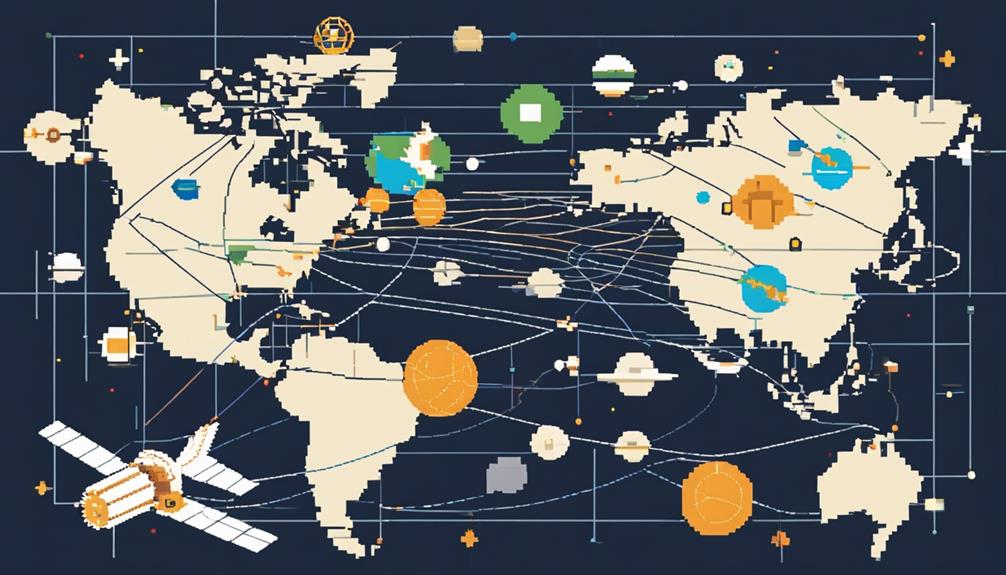Inter-Satellite Links (ISLs) represent a critical advancement in satellite communication systems, facilitating rapid data exchange among satellites. The intricate web of connections forged by ISLs enhances operational efficiency and responsiveness, particularly in dynamic orbital environments. However, the intricate interplay of factors influencing ISL performance and reliability poses intriguing challenges that warrant deeper exploration. Understanding the nuances of ISL technology is not merely about connectivity but delving into the intricate dance of signals in the vast expanse of space.
Key Takeaways
- ISLs enhance satellite communication via laser tech.
- Security and encryption vital for ISL data protection.
- Operational efficiency crucial for ISL network integrity.
- Future trends in ISL tech include higher data rates.
Importance of Inter-Satellite Links

The significance of Inter-Satellite Links (ISLs) lies in their fundamental role in enhancing the efficiency and performance of communication satellite services through high-speed data transmission capabilities within satellite constellations. ISLs, particularly optical inter-satellite links, play a crucial role in enabling seamless data relay between satellites. By establishing these links, satellites can exchange data at a much higher rate than traditional methods, leading to improved connectivity and operational efficiency within the satellite network.
The demand for higher data transmission speeds in satellite communication has driven the development and implementation of ISLs. With the increasing competition for orbital slots in key regions, ISLs have become indispensable for efficient resource utilization and to prevent network saturation. The use of optical ISLs offers a significant advantage over conventional systems by providing a faster and more reliable means of transferring data between satellites within a constellation.
In various GEO-to-GEO applications, ISLs have proven to be instrumental in enhancing connectivity and operational flexibility. Criteria have been established to evaluate the suitability of ISL applications, ensuring optimal performance and compatibility within satellite networks. Through tailored payload configurations and technology assessments, ISL models are designed to enhance communication capabilities in space and support the evolving needs of satellite communication services.
How Inter-Satellite Links Work
Facilitating high-speed data transmission between satellites within a constellation, Inter-Satellite Links (ISLs) establish direct communication channels that enhance operational efficiency and reduce reliance on ground stations. ISLs primarily operate using laser communication technology, allowing for the transmission of data at incredibly high data rates. This method of communication offers significant advantages over traditional radio frequency (RF) links commonly used in satellite networks.
By utilizing laser communication, ISLs enable satellites to exchange large amounts of data swiftly and securely. This technology is particularly crucial for applications in Low Earth Orbit (LEO) where time-sensitive data transmission is essential. Unlike RF links that may be susceptible to interference, optical ISLs provide a more reliable and secure means of communication between satellites.
Moreover, the use of ISLs reduces the need for constant communication with ground stations, thereby enhancing the autonomy and operational flexibility of satellite constellations. This is especially beneficial for missions requiring rapid response times or those operating in remote locations where ground stations may be scarce. Overall, the implementation of Inter-Satellite Links revolutionizes satellite communication by offering a more efficient, secure, and high-speed data transmission method within satellite constellations.
Advantages of ISL Technology

Inter-Satellite Links (ISLs) offer significant advantages in satellite communication networks. These advantages include faster data transfer rates, enhanced network connectivity, and improved communication coverage. By leveraging ISL technology, satellite missions can achieve improved efficiency and reliability in transmitting high-capacity data across space networks.
Faster Data Transfer
How does ISL technology revolutionize data transfer speed among satellites in a constellation? Inter-Satellite Links (ISLs) leverage optical technology to enable rapid transmission of data between satellites in space systems. By utilizing optical ISLs, satellites can achieve high data capacity and speed, enhancing inter-satellite communications significantly. This technology facilitates faster data transfer and increased bandwidth capabilities, crucial for sectors such as telecommunications, broadband, military, and earth observation. ISLs reduce the waiting time for accessing ground stations, offering flexibility to select the nearest satellite for downlink tasks. Particularly beneficial in Low Earth Orbit (LEO) scenarios, ISLs play a vital role in time-sensitive data operations and formation flying applications. The market potential for optical ISL technology is projected to reach $3 billion in the coming decade, underscoring its growing importance in space communication networks.
Enhanced Network Connectivity
Enhancing network connectivity through the utilization of Inter-Satellite Links (ISL) technology revolutionizes inter-satellite communications within space systems. ISLs enable high-speed data transmission between satellites, reducing wait times for ground station access. They enhance tasking flexibility, allowing satellites closest to specific downlink locations to handle time-sensitive data operations efficiently, especially in Low Earth Orbit (LEO). Crucial for various applications like telecommunications, broadband services, and military operations, ISLs create cost-effective interconnected constellations. Optical ISLs, despite challenges like cost and market immaturity, offer high bandwidth and speed, making them ideal for inter-satellite communications. Utilizing both microwave and optical terminals would further optimize the network connectivity and operational efficiency of space systems.
| Advantages of ISL Technology |
|---|
| High-speed data transmission |
| Enhanced tasking flexibility |
| Cost-effective interconnected constellations |
Improved Communication Coverage
The optimization of communication coverage within interconnected satellite constellations is significantly advanced through the utilization of Inter-Satellite Links (ISL) technology. ISLs offer several advantages in improving communication coverage:
- Coverage optimization, satellite handoff: ISLs enable seamless communication handoff between satellites, ensuring continuous coverage as satellites move across the sky.
- Signal resilience, data redundancy: By transmitting data through multiple paths, ISLs enhance signal resilience and provide data redundancy, reducing the risk of data loss.
- Network scalability, data prioritization: ISL technology allows for the scalability of satellite networks, enabling efficient data prioritization and management for various applications.
- Efficient data operations: ISLs facilitate high-speed data transmission between satellites, enhancing overall communication efficiency and meeting diverse satellite communication needs.
Types of Inter-Satellite Links

Inter-Satellite Links (ISLs) can be classified into different types based on the underlying technology used for communication between satellites. The two primary types of ISLs are RF (radiofrequency) and optical links. RF ISLs employ radio waves for transmitting data between satellites, while optical ISLs use lasers to achieve the same purpose.
When comparing RF and optical ISLs, optical links offer several advantages. Optical ISLs provide higher data rates, making them capable of transferring more information in a given time frame. Moreover, optical ISLs exhibit greater resistance to interference, ensuring more reliable communication between satellites. In contrast, RF ISLs are subject to ITU frequency regulations due to the use of radio waves, which can affect their operational flexibility.
Both RF and optical ISLs are integral for enhancing communication capabilities among satellites. While optical ISLs excel in speed and interference resilience, RF ISLs continue to serve a crucial role in satellite communication networks. Understanding the differences between these two types of ISLs is essential for designing efficient and reliable communication systems in space missions.
Applications of ISLs in Space Missions
In the realm of space missions, the utilization of Inter-Satellite Links (ISLs) extends beyond mere connectivity, playing a pivotal role in enabling high-speed data transmission and enhancing operational efficiency. ISLs are integral in various applications within space missions, revolutionizing the way data is transferred and enhancing overall mission success. Key applications of ISLs in space missions include:
- Space Exploration: ISLs are crucial for transmitting vast amounts of data between satellites during space exploration missions. They facilitate real-time communication and data exchange, enabling missions to collect and analyze data efficiently.
- Data Transfer Efficiency: ISLs significantly enhance data transfer efficiency by enabling direct communication between satellites, reducing the reliance on ground stations. This results in faster data transmission rates and improved overall mission performance.
- Satellite Communication: ISLs play a vital role in enabling seamless communication between satellites in orbit. They support a wide range of satellite communication applications, including telecommunications, broadband services, military operations, and Earth observation missions.
- Operational Flexibility: ISLs provide operational flexibility by allowing satellites to communicate directly with each other, optimizing data transfer routes. This flexibility ensures that satellites can efficiently task each other based on proximity to downlink locations, reducing waiting times and enhancing operational efficiency in space missions.
ISLs in Satellite Constellations

Facilitating seamless satellite-to-satellite data transmission, Inter-Satellite Links (ISLs) within satellite constellations optimize operational efficiency and reduce reliance on ground infrastructure. These ISLs enable high-speed satellite connectivity, enhancing space data relay and orbital communication. By establishing direct links between satellites, ISLs eliminate the need for routing data through ground stations, thereby improving data transfer speeds and reducing latency.
Satellite constellations leverage ISLs to enable flexible tasking, allowing for efficient downlinking from the nearest satellite. This capability is particularly beneficial in low Earth orbit (LEO) missions where time-sensitive data operations are critical. ISLs play a crucial role in various applications, including telecommunications, broadband services, military communications, Earth observation, and formation flying missions.
Interconnected constellations equipped with ISLs offer practical and cost-effective solutions compared to relying solely on ground stations for data relay. In LEO satellite operations, ISLs contribute to low latency data transmission, enhancing operational efficiency and overall mission effectiveness. The utilization of ISLs in satellite constellations represents a significant advancement in optimizing satellite connectivity, space data relay, and orbital communication for a wide range of space-based applications.
Challenges in Implementing ISLs
Challenges arise in the implementation of Inter-Satellite Links (ISLs) due to the significant costs associated with market immaturity, as well as the demanding size, weight, and power requirements involved. These challenges can be further categorized as follows:
- Budget Constraints: The high costs of implementing ISLs pose challenges for satellite operators, especially when operating within constrained budgets. The need to invest in expensive technology and infrastructure can strain financial resources, limiting the widespread adoption of ISLs.
- Technology Advancements: Keeping up with rapid technological advancements is crucial in ISL implementation. Satellite systems need to constantly evolve to incorporate the latest innovations such as modularization and miniaturization to address the size, weight, and power constraints while enhancing overall performance.
- Operational Challenges: Integrating ISLs into satellite systems introduces operational complexities. Mission planning and execution become more intricate, requiring additional resources and expertise to manage the interconnected network effectively.
- Resource Intensiveness: The introduction of ISLs adds a layer of resource intensiveness to satellite operations. Components like transceivers and controllers increase the complexity of spacecraft design, necessitating meticulous planning and execution to ensure seamless integration and operation.
Security Considerations for ISLs

Ensuring robust encryption protocols and implementing secure authentication methods are paramount in safeguarding Inter-Satellite Links (ISLs) against potential threats. Encryption plays a crucial role in protecting the confidentiality and integrity of data transmitted over ISLs, while authentication mechanisms help verify the identities of communicating satellites. By focusing on these key security considerations, the risks of unauthorized access, data tampering, and signal interference can be effectively mitigated within ISL networks.
Encryption for ISLs
Encryption plays a pivotal role in ensuring the secure transmission of data between interconnected satellites through Inter-Satellite Links (ISLs).
- Advanced encryption algorithms protect ISL communications, ensuring secure communication channels.
- Encryption standards like AES (Advanced Encryption Standard) are commonly utilized to maintain data privacy.
- Secure key management protocols are crucial for safeguarding encryption keys, enhancing ISL security.
- Encryption is essential for preserving the confidentiality and integrity of sensitive information exchanged through ISLs.
Authentication Methods
Authentication methods play a critical role in establishing trust and verifying the identity of interconnected satellites for secure communication through Inter-Satellite Links (ISLs). These methods ensure data integrity, prevent unauthorized access, and protect sensitive information exchanged between satellites. Techniques such as encryption and authentication protocols are crucial for safeguarding the confidentiality of ISL communications. Secure key exchange protocols play a vital role in establishing a secure channel between satellites. By implementing robust authentication measures, risks of cyber threats can be mitigated, and the overall security of ISL transmissions can be enhanced.
| Authentication Methods | Benefits | Implementation |
|---|---|---|
| Encryption Protocols | Ensures data confidentiality | Utilizes cryptographic algorithms |
| Authentication Protocols | Verifies satellite identity | Implements secure handshake procedures |
| Key Exchange Mechanisms | Establishes secure communication channel | Utilizes public-key infrastructure |
Interference Management in ISLs
Interference management plays a critical role in maintaining the integrity and reliability of inter-satellite links (ISLs) by safeguarding against signal degradation or loss caused by external sources. To ensure the effectiveness of ISL communications, various techniques are employed:
- Encryption Techniques: Implementing encryption methods helps protect ISL communications from unauthorized access and data tampering, ensuring the confidentiality and integrity of transmitted information.
- Interference Mitigation: Countermeasures such as beam steering and diversity techniques are utilized to mitigate interference from sources like jamming or hacking, enhancing the robustness of ISL connections.
- Signal Quality Maintenance: Maintaining a high level of signal quality is vital for the reliable operation of ISLs. Techniques like modulation schemes and error correction mechanisms are applied to sustain signal integrity.
- Security Measures: Robust security protocols are essential to safeguard ISL networks from potential threats. By establishing secure communication channels and authentication mechanisms, the confidentiality and reliability of data transmitted through ISLs can be assured.
Incorporating these strategies into ISL systems is crucial for preserving the operational efficiency and data integrity of satellite communications in the presence of external interference.
Cost Factors of ISL Implementation

When considering the implementation of Inter-Satellite Links (ISLs), assessing the cost factors is crucial. Factors such as budget allocation, financial impact, and overall cost considerations play a significant role in determining the feasibility and success of integrating ISLs into satellite missions. Understanding the financial implications of ISL implementation is essential for effective project planning and resource management.
Cost Considerations
In considering the implementation of Inter-Satellite Links (ISLs), the cost factors are intricately influenced by factors such as payload sizing, critical subsystem technologies, and the level of technology readiness. When analyzing the costs associated with ISL implementation, several key considerations come into play:
- Cost Analysis: Evaluations involve comparing costs between ISL and non-ISL systems to determine cost-effectiveness.
- Technology Readiness: Identification of key technology areas and estimation of schedule and cost help advance ISL technology readiness.
- Integration Challenges: Assessments of technological availability guide the cost analysis and sizing for ISL integration.
- Subsystem Technologies: Cost analysis for ISL implementation considers critical subsystem technologies and overall system cost comparisons.
Budget Allocation
Efficient budget allocation for the implementation of Inter-Satellite Links (ISLs) is crucial for balancing performance requirements with cost-effective solutions to maximize the benefits of intersatellite communication systems. Budget management, cost efficiency, and resource allocation are key considerations in ensuring the successful deployment and operation of ISLs. The table below outlines the primary cost factors for ISL implementation, emphasizing the need for strategic budget planning to address hardware components, software development, testing, integration, and ongoing maintenance costs. By carefully managing the budget for ISL projects, organizations can optimize their investments and achieve sustainable operation of inter-satellite communication systems.
| Cost Factors | Description | Importance |
|---|---|---|
| Hardware Components | Customized equipment tailored for space applications to enable seamless communication between satellites | High |
| Software Development | Specialized programs for ISL functionality and data exchange | Critical |
| Testing | Rigorous testing procedures to ensure system reliability and performance | Essential |
| Integration | Seamless integration of ISL technology into existing satellite systems | Crucial |
Financial Impact
To effectively manage the financial impact of implementing Inter-Satellite Links (ISLs), a comprehensive analysis of cost factors associated with hardware, software, testing, integration, and ongoing maintenance is essential for satellite operators and mission planners.
Cost Factors of ISL Implementation:
- Implementing ISLs can increase overall mission costs due to additional hardware and software requirements.
- The cost of ISL implementation is influenced by factors like payload sizing, technology readiness, and system complexity.
- ISLs necessitate careful financial analysis to determine the most cost-effective integration approach.
- Cost factors include development time, power consumption, mass constraints, and specialized equipment needs.
Balancing the financial impact of ISL implementation with the benefits they offer requires strategic financial planning, cost optimization, and budget allocation.
Future Trends in ISL Technology

The evolution of Inter-Satellite Links (ISLs) technology is poised to revolutionize satellite communications infrastructure in the coming years. Future innovations in ISL technology are driving significant market growth, with optical ISL technology projected to reach a $3 billion market size within the next decade due to the increasing demand for high-capacity data transmission.
Technological advancements in the field include the scaling up of production of laser communication equipment by companies like Mynaric and the integration of laser communication terminals on satellites by SpaceX's Starlink. Optical ISLs are particularly promising as they offer higher data rates and enhanced security against interception, making them optimal for inter-satellite communications in an increasingly data-intensive environment.
To meet the demands of interconnected Low Earth Orbit (LEO) constellations, companies are developing hybrid optical/RF data relay networks. These networks leverage the advantages of optical ISLs, which require fewer adaptations for integration into existing systems like Galileo, providing a more efficient and effective solution for satellite communication needs.
Conclusion: The Future of ISLs
Continuing the trajectory of technological advancements and market growth, the future of Inter-Satellite Links (ISLs) is anchored in the validation of their capabilities and deep integration into satellite communication systems. This future is intricately linked to three key areas of development:
- Efficiency Optimization: ISLs are continually being refined to maximize data transfer rates while minimizing power consumption, ensuring efficient use of resources in satellite networks.
- Reliability Testing: Rigorous testing protocols are being established to assess the robustness of ISLs under various operating conditions, guaranteeing reliable communication links between satellites.
- Integration Advancements: Efforts are underway to seamlessly integrate ISLs into existing satellite systems like Galileo, streamlining interoperability and enhancing overall network performance.
- Navigation System Integration: The future of ISLs involves deeper integration into navigation systems such as Galileo, paving the way for enhanced satellite communication services and improved orbital resource management.
Frequently Asked Questions
What Is an Inter-Satellite Link?
An inter-satellite link (ISL) facilitates communication between multiple satellites in space, enabling the exchange of data and commands without ground station reliance. The benefits include enhanced operational efficiency, reduced wait times for data transmission, and improved tasking flexibility. Challenges may arise in ensuring seamless connectivity and managing complex network configurations. Future applications of ISLs span various sectors, including telecommunications, military operations, and earth observation, while security implications necessitate robust encryption and authentication protocols.
What Are the Three Types of Satellite Communication Links?
Satellite communication links include uplink, downlink, and crosslink. Uplink enables data transmission from a ground station to a satellite, downlink facilitates the transfer of data from a satellite to a ground station, and crosslink allows communication between satellites within a constellation. These links are vital for ensuring comprehensive satellite coverage, efficient data transmission, and optimal signal strength in satellite communication systems.
What Is Optical Inter-Satellite Links?
Laser communication in space, known as optical inter-satellite links (OISL), revolutionizes space connectivity by enabling high-speed and secure data transfer between satellites. Utilizing laser or optical technology, OISL offers superior data rates and bandwidth compared to traditional radiofrequency links. Despite challenges like cloud cover and atmospheric disturbances affecting optical downlinks, OISL remains a cutting-edge solution for inter-satellite communications due to its speed, reliability, and potential for market growth.
What Frequency Are Intersatellite Links?
Frequency bands utilized by intersatellite links (ISLs) include S-band, Ku-band, and optical frequencies. These bands determine signal strength and data rates. S-band operates within 2-4 GHz, while Ku-band ranges from 12-18 GHz, offering varying capabilities. Optical frequencies, like 1.55 micrometers, promise high data rates and security. Selection is based on factors like data requirements and interference, highlighting technology maturity as a crucial consideration in ISL frequency choice.

